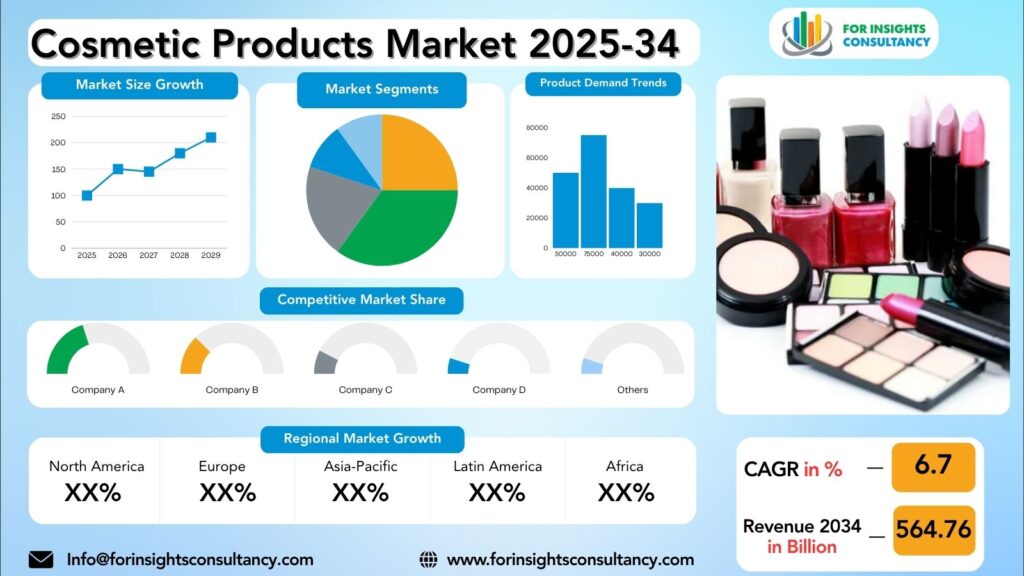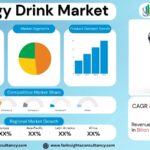
Cosmetic Products Market Size, Trends Analysis Research Report By Product Type (Skincare, Haircare, Color/Make-up, Fragrances/Deodorants, Bath & Shower, Oral Care)), by Formulation Type (Natural & Organic, Conventional), by Gender, by end user, and By Region Global Market Analysis And Forecast, 2025-2034
Oct-2025 Formats | PDF | Category: Consumer Goods | Delivery: 24 to 72 Hours
Global revenue from the Cosmetic Products market is foreseeable at US$ 252.89 Billion in 2025 and has been truthful to current at a CAGR of 6.7% to extent US$ 564.76 Billion by the end of 2034.
Cosmetic Products Market Research Summary
The market for cosmetic products is an ever-changing industry, which changes along with the demands of consumers and different trends. This extensive overview is meant to provide the insights about the market’s present state and its upcoming changes.
The cosmetic products market is forecasted to be extremely profitable in later years, as a result of the factors such as raising disposable income, changing lifestyle trends, and growing awareness of personal grooming.
The market is full of competition, with the major players such as L’Oréal, Estée Lauder, and Procter & Gamble being the leaders in the industry. These corporations spend a lot of money on research and development in order to introduce new products and maintain their position in the market.
The shift to clean and sustainable beauty products is a market trend, with consumers being more and more conscious of the ingredients in their skincare products. To serve the increasing demand, brands are adopting more eco-friendly packaging and cruelty-free formulations.
The coming time of the cosmetic products market is dependent on technological breakthroughs, such as artificial intelligence and augmented reality, which will change the consumers’ way of experiencing and buying beauty products. The popularity of personalized skincare and virtual try-on tools will grow, thereby improving the overall consumer experience.
Market Insights
- By 2024, the Cosmetic Products Market is projected to see significant growth, with the largest regional revenue share expected to come from the Asia-Pacific region, driven by the increasing demand for skincare and beauty products.
- The growth forecast for this region is estimated to be around 7-9% annually. In the U.S., approximately 82% of the population is expected to reside in urban areas by 2024, indicating a high concentration of potential customers for cosmetic products.
- In terms of market segments, the largest revenue share is predicted to come from skincare products, followed by haircare and makeup products.
- Consumers’ increasing focus on natural and organic ingredients is expected to drive growth in these segments. Overall, the Cosmetic Products Market in 2024 is poised for robust growth, particularly in the Asia-Pacific region and within key product segments.
Market Dynamics
Trends
Sustainable Beauty: The consumer base is turning to eco-friendly and sustainable cosmetic products as their main priority. This has caused the market to move towards the use of natural ingredients, recyclable packaging, and the adoption of cruelty-free practices.
Digital Transformation: The beauty industry is full of digital innovations that it cannot resist. Some of such innovations are augmented reality tools for virtual makeup try-ons, AI algorithms for personalized skincare recommendations, and online beauty consultations.
Gen Z Influencers: The Gen Z influencers represent one of the major forces that change the face of the cosmetic products market. They do it by their realness in dealing with beauty, diversity, and inclusiveness, which in turn, affect product development and marketing strategies.
Wellness Integration: The merger of skincare, beauty, and wellness products concepts is becoming louder by the day. The focus is on holistic approaches to beauty from the inside out, thus the presence of ingestible beauty supplements and stress-relief skincare products.
Customization and Personalization: The trend of demand for cosmetic products that are tailor-made has gone higher. Brands are offering personalized beauty solutions based on individual skin concerns, preferences, and lifestyle choices.
Growth Drivers
Demand for natural and organic cosmetic products significantly increased due to extensive public knowledge of sustainable and eco-friendly practices. Consumers are actively seeking natural and organic cosmetic products, which has become a major driver of the market.
Technological innovations keep the product offerings fresh and attractive to consumers. Examples are personalized skincare solutions and smart beauty devices. Such innovations have been a major factor for the growth of the market.
The rise in disposable incomes together with the urbanization trend has resulted in an increase of the cosmetic product consumer base. This is particularly true for the emerging markets where most of the new customers originate.
Influencer marketing and the usage of social media platforms for communication have been instrumental in product visibility and therefore in customer acquisition. The cosmetic products market benefits immensely from these new channels of communication.
One of the factors contributing to the overall growth of the cosmetic products market is the increased male grooming market. The improved image of the male grooming products and the increased number of male users have been the main drivers of the male grooming market.
Restraints
Stringent Regulations: The ever-increasing regulatory requirements may slow down product innovations and restrict market expansion.
Sustainability Challenges: Growing awareness of the environmental impact may result in higher production costs for eco-friendly packaging and certified ingredients.
Supply Chain Disruptions: The supply chain can be disrupted by unforeseen events such as natural disasters or trade disputes, thus product availability will be affected.
Changing Consumer Preferences: Changes in consumer demand for natural, organic, or cruelty-free products may force enterprises to make changes in their product portfolio.
Economic Uncertainty: The economy’s ups and downs can influence consumers’ spending habits, thus the sales of cosmetic products will be affected.
Intense Competition: The competition can be intensified due to the saturation of the market and the appearance of new competitors, thus leading to price wars and pressure on margins.
Opportunities
Growing Demand for Natural and Organic Products: Natural products with less chemical additives continue to attract the attention of consumers, thus, companies have a chance to broaden their product lines in this segment.
Rise of E-commerce: Moving toward online shopping is a powerful weapon for cosmetic brands to get many new customers quickly and have different ways of distributing their products.
Personalized Beauty Solutions: The beauty industry is flooded with customized makeup products and personal skincare routines that have become very popular, thus companies can offer tailored solutions to meet individual consumer needs.
Sustainability and Eco-friendly Packaging: Customers are becoming more green-minded and thus more demanding of the industry to adopt environmental-friendly packaging solutions.
Innovation in Anti-aging Products: An increasing market for cutting-edge anti-aging products that provide real benefits is the global aging population trend.
Thus, the cosmetic products market in 2024-2025 is full of potentials to attract the consumers who change their preferences and follow the sustainability trends.
Challenges
Shift towards Clean Beauty: Cosmetic companies face the challenge of reformulating their products as a result of an increasing consumer demand for clean and natural ingredients.
Sustainability Pressures: To reduce their environmental impact, brands are compelled to implement sustainable practices in packaging and sourcing of raw materials.
Regulatory Compliance: Adapting to changes in regulations concerning the safety of cosmetics and testing requirements is a difficult task faced by companies that operate in multiple markets.
Rising Competition: As a result of the increased number of new entrants and indie brands in the market, it is becoming more difficult for the existing companies to distinguish themselves.
Digital Transformation: Being able to respond to the changes in e-commerce and social media marketing is a must for cosmetic companies if they want to be able to reach their target audience in an efficient manner.
Cosmetic Products Market Top Companies Covered In This Report:
Evaluate The Strategic Positioning And Innovation Pipelines Of Leading Market Companies-From Multinational Enterprises To Disruptive Regional Firms. Understand How Key Players Are Innovating, Expanding, And Capturing Value, And Use Competitive Benchmarks To Plan Your Next Move.
- Unilever
- Estée Lauder Companies
- Procter & Gamble
- Shiseido
- LOréal
- Coty Inc
- Amorepacific Corporation
- Beiersdorf AG
- Kao Corporation
- Johnson & Johnson
- LVMH
- Mary Kay Inc
- Revlon Inc.
- Natura &Co
- LG Household & Health Care
Cosmetic Products Market Company News 2024 and 2025
L’Oréal
L’Oréal entered a 10% stake in Jacquemus and secured a long-term partnership for perfumes and make-up (Feb 2025).
Unilever
Unilever reported 2024 sales growth of 4.2% (beauty & wellbeing up 6.5%) and underlying operating margin rose to 18.4%.
Coty Inc
Coty Inc. delivered Q1 FY25 growth (net revenues +2% reported, +4.5% like-for-like) and expanded its fragrance license deal with Swarovski.
Shiseido
Shiseido reported annual operating profit plunge of 73.1% for year ending 31 Dec 2024, largely due to weak consumer spending in China
Key Segments
Segmentation By Product Type
- Skincare Products
- Haircare Products
- Color/Make-up Products
- Fragrances & Deodorants
- Bath & Shower Products
- Oral Care Products
Segmentation By Formulation Type
- Natural & Organic
- Conventional (Synthetic)
Segmentation By End-User / Gender
- Women
- Men
- Unisex
- Children/Teens
Segmentation By Distribution Channel
- Online Retail
- Supermarkets/Hypermarkets
- Specialty Stores
- Drug Stores/Pharmacies
- Convenience Stores
- Direct Selling
Segmentation ByPrice Category
- Mass/Value Segment
- Mid-Range Segment
- Premium/Luxury Segment
Global Geographic Coverage:
The Report Provides In-Depth Qualitative And Quantitative Data On The Cosmetic Products Market For All Of The Regions And Countries Listed Below:
North America
The cosmetic product market is booming in North America with a forecasted GDP growth of 2.5% and an inflation rate of 1.8%. One of the peculiar drivers that significantly impact the market in the US is the increasing demand for cruelty-free products, which, in turn, is due to the raising consumer-awareness of animal-welfare issues. This development has been instrumental in the rise of e-commerce as the main channel for cosmetic sales, where, among other things, social media influencers have great impact in product promotion. However, the specialty beauty stores offering personalized shopping experiences are the quickest-growing channel.
Consumers in Canada are mainly concerned with sustainability and ethical sourcing and thus, eco-friendly and cruelty-free products are among their must-haves. Consumers in Mexico, on the other hand, are more inclined towards localism and thus, they patronize indigenous brands that not only reflect their cultural heritage but are also familiar to them. In fact, in the emerging markets such as Brazil and Colombia, price and social status are still the major determinants of purchasing decisions.
Europe
For the European cosmetic products market, the projected GDP Growth and Inflation Rate in the region are the major economic indicators that determine consumer behavior. The market is highly diversified, and each sub-region is influenced by different factors. As an example, in France, the main driver is the cultural importance of beauty and skincare, and the government is providing a specific subsidy to promote organic and eco-friendly products. The leading channel in this market is retail stores, whereas e-commerce is the fastest-growing channel because of the convenience and accessibility. Consumers in Europe are focused on sustainability, ethical sourcing, and localism, and they require transparency and eco-friendly practices from brands. On the other hand, in markets that are still developing and where price and status are the most important factors, such as in Eastern Europe, affordability and prestige are the factors that influence consumer choices the most.
Asia Pacific
The predicted GDP growth and inflation rate are the major factors that determine the consumer behavior and purchasing power in the cosmetic products market in Asia Pacific. Each sub-region of the Asia Pacific has a different set of advantages and issues. For instance, in the region of Southeast Asia, a particular government subsidy that supports the local beauty brands is the factor that most influences the consumers’ decision.
The main channel for cosmetic products in Asia Pacific is e-commerce, and offline retail is also contributing to the consumer reach. Yet, the quickest expanding channel is social commerce, which is a fan of influencer marketing and digital platforms.
Consumers in the Asia-Pacific region are progressively more concerned with sustainability, ethical sourcing, and localism when they purchase cosmetic products. The trend is strongly pronounced in such markets as Japan and South Korea.
In the majority of the Asia Pacific’s emerging markets, prices and status are the most influential factors to the purchasing decisions. Therefore, affordability and perceived value are the most important considerations for consumers.
Middle East and Africa
The Cosmetic Products Market in the Middle East and Africa, and the sub-regions, is maintaining a positive trend over time which is mainly attributable to the region’s GDP Growth of 3.5% and Inflation Rate of 4.2% that were both forecasted. In Saudi Arabia, the government subsidy on domestically-produced cosmetics is a unique sales driver that gives an enormous boost to sales. The primary channel for cosmetic products in the UAE is luxury department stores, while e-commerce is the fastest-moving channel in Egypt. Consumers in South Africa focus on the environment and the ethical sourcing of products, thus, these two points are the minimum requirements for cosmetic brands in the local market. In a number of emerging markets across the region, price and status are still the main factors that determine consumer preferences and thus their purchasing decisions.
Frequently Asking Questions
What is the Cosmetic Products market size and growth forecast?
Cosmetic Products Market is predicted to grow from USD 252.89 Billion in 2025 to approximately USD 564.76 Billion by 2034. the industry is estimated to expand at a CAGR of 6.7%.
Who are the key players in the Cosmetic Products market?
The Cosmetic Products Market Includes Major Companies LOréal, Estée Lauder Companies, Procter & Gamble, Shiseido, Unilever, Coty Inc, Amorepacific Corporation , Beiersdorf AG , Kao Corporation, Johnson & Johnson, LVMH, Mary Kay Inc, Revlon, Inc., Natura &Co, LG Household & Health Care, Others.
What are the current and future trends for Cosmetic Products market?
Current trend in the Cosmetic Products market: Growing demand for clean and natural beauty products.
Future trend in the Cosmetic Products market: Increasing focus on personalized skincare solutions and sustainability.
What are the challenges facing the Cosmetic Products market?
Challenges facing the Cosmetic Products market include increasing competition, rising consumer demand for natural and sustainable products, regulatory complexities, and the impact of social media influencers on brand reputation.
Which regions dominate the Cosmetic Products market?
The cosmetic products market is dominated by Asia-Pacific, driven by high consumer demand in China, Japan, South Korea, and India.
Report Features
This report gives the most complete information. The report on Cosmetic Products Market format has been designed so that it can provide the best value to the business. It offers crucial insights into the market’s dynamic and will aid in strategic decision-making for current players as well as those looking to join the market.
What Deliverables Will You Get in this Report?
|
Key questions this report answers |
Relevant contents in the report |
|
How big is the sales opportunity? |
In-depth analysis of the Global Cosmetic Products Market |
|
How lucrative is the future? |
Market forecast and trend data and emerging trends |
|
Which regions offer the best sales opportunities? |
Global, regional and country level historical data and forecasts |
|
Which are the most attractive Cosmetic Products market Key segments? |
Market segment analysis and |
|
Which are the top Key players and Their Cosmetic Products market
positioning? |
Competitive landscape analysis, Market share analysis |
|
How complex is the business environment? |
Porter’s five forces analysis, PEST analysis, Life cycle analysis |
|
What are the factors affecting the Cosmetic Products market? |
Drivers & Restraints |
|
Will I get the information on my |
Customized Report as per your Business Needs Our analysts will work directly with you and understand your needs Get data on specified regions or segments, competitor and Vendors Data will be formatted and presented as per your requirements Any Requirement Contact Us: Https://Www.Forinsightsconsultancy.Com/Contact-Us |
Table of Contents
For TOC Contact us: https://forinsightsconsultancy.com/contact-us/






